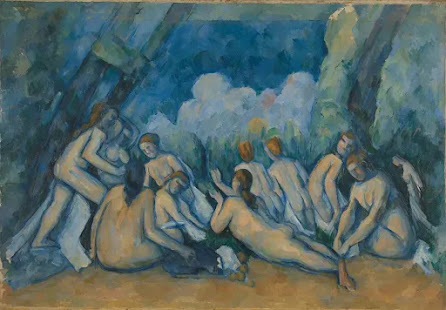Paul Cezanne 1839-1906
Around 200 of Cézanne’s works depict male and female nude bathers, either singly or in groups, in a landscape. The earliest dates from the 1870s. This large painting is one of three pictures of female bathers that Cézanne worked on during the final decade of his life. The largest of all his paintings, they represent the culmination of his lifelong investigation of this subject and the climax of his entire career. They were hugely influential on early twentieth-century modern art, particularly Cubism, and had a lasting impact on Picasso and Matisse.
The precise dating of the pictures is difficult. It’s possible that Cézanne worked simultaneously on all three canvases, beginning in the mid-1890s and continuing until his death in 1906, as each shows evidence of reworking. The first of the three, possibly begun in 1895 and of a similar size to the National Gallery’s picture, is now in the Barnes Foundation, Philadelphia. The National Gallery’s painting is generally acknowledged to be the second to have been started. It may date from 1898–9 and was finished in 1905. As he worked on the picture, Cézanne decided to reduce the area of sky and folded the top of the canvas over the stretcher on which it was mounted, which only became apparent when the picture was re-stretched long after his death. The third picture is now in the Philadelphia Museum of Art and relates most closely to the work in the National Gallery. Perhaps painted relatively quickly in the last months of Cézanne’s life, it was left unfinished with areas of canvas still showing through.
All three pictures draw upon a classical tradition of pastoral scenes of nude or semi-nude figures in an idealised landscape, which extended from the Renaissance to artists such as Manet and Renoir. More particularly, they recall paintings of bathing nymphs and pagan goddesses, especially sixteenth-century Venetian mythological scenes such as Titian’s Diana and Actaeon and Diana and Callisto. However, Cézanne’s paintings have no mythological narrative or literary source, nor are any men present. The locations are unspecified, although the landscapes recall Provence, where Cézanne lived.
Of the three paintings, the National Gallery’s is arguably the strongest and simplest in composition. It is also the most fully painted and richly coloured. We are looking at a frieze-like group of 11 nude women relaxing in a woodland glade beneath an azure sky. The picture does not include the water in which the women bathe. Placed before them is a still life and a black dog. Several of the women have their backs towards us, and their faces are either mask-like or turned away. Filling the foreground, most of them lean in towards the middle of the picture. The strong diagonals of their bodies form the base of a pyramid that has echoes of Mont Sainte-Victoire overlooking Aix-en-Provence (where Cézanne was born), which the artist painted numerous times. Although each woman is distinct, they also form a single, almost sculptural mass. Throughout the picture, space is flattened and compressed. Cézanne has not used the conventions of atmospheric recession to create, for example, an effect of a distant sky that becomes paler towards the horizon – indeed, the blue here becomes darker nearest the clouds. The brilliant blue of the sky is as intense as other areas of the picture, and Cézanne has undone perspective by making the sky and clouds as substantial as the earth, trees and women.
Touches of blue are repeated throughout the picture. These not only represent dappled light, but contrast with warmer areas of orange, yellow and ochre. Blue also integrates the women with their surroundings, particularly through Cézanne’s use of a broken blue outline, reinforced by black, around each of them. These bodies are not physically separate from the landscape, but are part of it. This merging is especially apparent in the standing woman on the far left of the group. Her pale skin contains emphatic slashes of blue (for example, on her thigh), but her head is dark, its earthy tones close to the grey-brown tree trunk behind it. The diagonal line of that tree is repeated by her left leg, back and neck, just as the line of her right thigh is mirrored by her right forearm and the almost square top of her right shoulder. These lines, particularly the diagonal of her leg and right angle of her arm, are reiterated in the outline of the larger woman seated on the ground to her right.
Cézanne’s often crude distortions of the body may in part be the result of his awkwardness in figure drawing. He also admitted to the painter Emile Bernard that he was too shy to hire models when working on these pictures, relying instead on memories from visits to museums and the academic studies of his youth. But these distortions also give the women an architectural quality that harmonises with their surroundings, as seen most obviously in the standing woman on the left. As solid as the ground they lie upon, the women become one with the landscape they inhabit. Cézanne’s last paintings might perhaps be seen as his final celebration of nature and as an idyllic, even utopian, vision of our union with it.

Aucun commentaire:
Enregistrer un commentaire